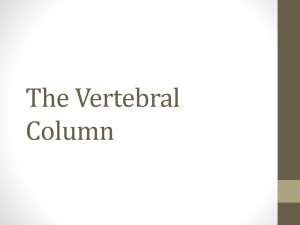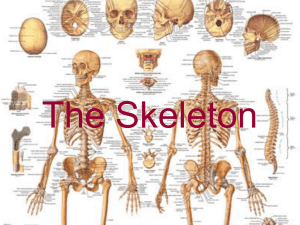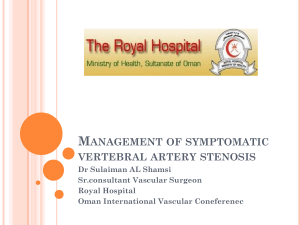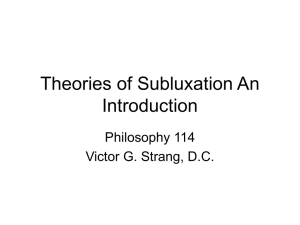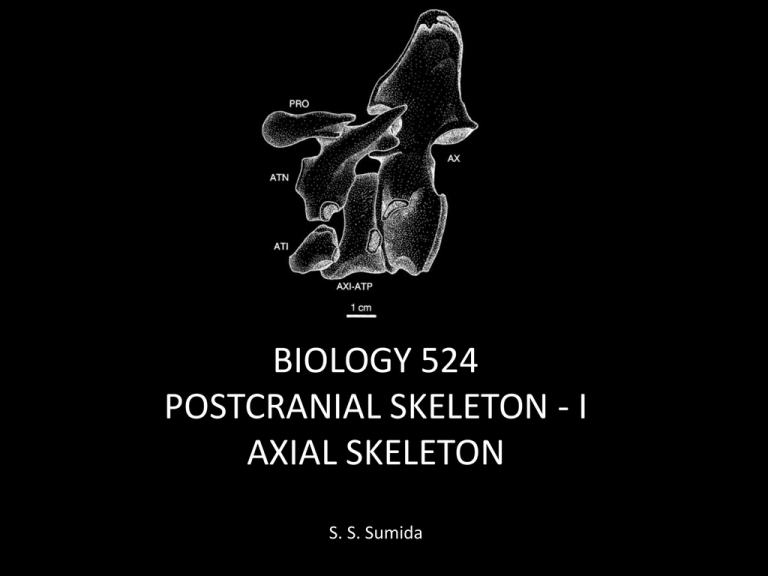
BIOLOGY 524
POSTCRANIAL SKELETON - I
AXIAL SKELETON
S. S. Sumida
INTRODUCTION
The axial skeleton is generally considered one of
the hallmark features of vertebrates; it is after all,
the namesake of the group. However, the idea
that the group was defined by having vertebrae
or a vertebral column turns out to be an
oversimplification.
NOTOCHORD
In fact, the beginnings of the axial skeleton of vertebrates,
both embryologically and phylogenetically is not about the
vertebral column. Rather it is about the notochord. The
notochord:
• Derived from mesoderm
• A trans-segmental structure immediately ventral to the
dorsal hollow nerve cord.
• A laterally flexible, but incompressible rod, that prevents
telescoping of the body in primitive vertebrates, as well
as embryos.
• It does not become the vertebral column, but is replaced
in varying degrees by structures of the sklerotome of the
somite.
VERTEBRAL COLUMN AND ASSOCIATED STRUCTURES
We will track the following significant trends:
• Eventual replacement of the notochord (in whole or in part) by
vertebrae.
• Reorganization of sklerotomal materials to facilitate terrestrial
biomechanics.
• Differing trajectories of emphasis on different structures depending
on whether tetrapods remain aquatic or become more terrestrially
adapted.
• Development and consolidation of the atlas-axis complex.
• In mammals and birds, the development of regionally specialized
sections of the vertebral column.
AXIAL STRUCTURE IN PRIMITIVE
VERTEBRATES
The subphylum Vertebrata is defined by the presence of
ectodermal placodes and neural crest tissue and
structures that develop from them.
The reason the “Vertebrata is not defined by vertebrae”
is because the most basal of vertebrates do not in fact
have a true vertebral column.
AXIAL STRUCTURE IN PRIMITIVE VERTEBRATES
Agnathans and even primitive gnathostomes do not have a fully ossified vertebral column.
Fossil agnathans show little or no evidence of an ossified vertebral column. With such highly
developed dermal armor, it may not have been necessary.
Living agnathans do not have much in the way of vertebral structures either.
• Hagfish: small, poorly developed haemal arches.
• Lampreys: small, poorly developed neural arches.
Even primitive living gnathostomes only have structures dorsally
and ventrally, with the notochord remaining the majority of the
mass of the axial skeleton.
Where dorsal structures rest on the top of the notochord, and
ventral structures attach to the underside of the notochord, there
are often supporting plugs of material that are dense, and
occasionally even become calcified cartilage.
Sharks and their relatives have fully developed vertebral central, as well as neural arches. In
the tail region, HAEMAL ARCHES combine to protect the caudal extension of the dorsal
aorta.
In the trunk region, the neural
arches are triangular in outline
laterally. This would leave a series
of triangular spaces between each
neural arch. But in sharks these
spaces are plugged by structures
known as INTERCALARY PLACES,
or interneural plates.
Vertebral central are
NOTOCHORDAL, with the
notochord persisting and running
through the center of each
centrum.
MEDIAN FINS OF FISHES
They are usually supported by midline extensions away from the vertebral column.
UNPAIRED MEDAN FINS include:
• One or more dorsal fins.
• In salmonid fishes, the second of the dorsal fins is fleshy with no bony support, and called
an ADIPOSE FIN.
• An ANAL FIN, sometimes called a ventral fin.
• The TAIL FIN.
BASIC STRUCTURES OF A SALMONID FISH
TAIL FIN STRUCTURE
HOMOCERCAL – tail that looks
externally symmetrical, but may
not be internally. (There are
many ways to build a homocercal
tail.)
HETEROCERCAL - tail in which
longer lobe is dorsal, usually with
vertebral column continuing into
it.
HYPOCERCAL – tail in which
longer lobe is ventral, usually
with vertebral column continuing
into it.
VERTEBRAL STRUCTURE FROM CROSSOPTERYGIAN
FISHES TO THE EARLIEST TETRAPODS
• Vertebral centra of crossopterygians are wedge-shaped, and triangular in outline in
lateral view. Small accessory structures sometimes called pleurocentra (singular =
pleurocentrum) may actually be intercalary plates.
• Neural arches become somewhat more erect.
• And although the earliest tetrapods appear to have remained largely aquatic, they must
have had to deal with gravity and the needs for support at least on occasion, as they do
demonstrate the development of zygapophyses.
• ZYGAPOPHYSES are structures for articulation between successive vertebral structures so
that each vertebra rests partially on the vertebral immediately caudal to it. This helps
resist ventral-ward collapse of the column in tetrapods.
To understand the difference between the INTERCENTRUM and PLEUROCENTRUM, the early
embryology of the vertebra must be understood.
To understand that, recall that the segmental somites are subdivided into dermatome,
myotome, and sklerotome. Key here is the sklerotome that will give rise to vertebral
structures, and the myotome which gives rise to the musculature that attaches to that
skeletal structure.
• The developing sklerotome (above) and myotome are initially in line with one another.
• This is not an advantageous means of attachment if the muscle is to act across a joint.
• Each sklerotome SPLITS into a cranial half and a caudal half, which then migrate away from
one another.
• This causes the cranial half of one sklerotome and the caudal half of that immediate forward
of it to move toward one another.
• When they touch the like tissues fuse, giving rise to a vertebral structure that is built from
caudal and cranial halves of adjacent sklerotomes.
• This results in myotomes/muscle blocks now spanning intervertebral joints, generating a
condition more useful for stabilizing the vertebral column and RESISTING SAGGING DUE TO
GRAVITY.
• This reorganized vertebra type is a PLEUROCENTRUM.
• A vertebra that doe not go through this reorganization is known as an INTERCENTRUM.
Notably, even when much of the vertebra resegments, sometimes small parts of the original
sklerotome does not. This is the intercentrum.
The original condition — i.e. the fish condition, the aquatic condition – is NOT to
resegment. To remains as an intercentrum.
What we will see is that those lineages of tetrapods that come to be more and
more terrestrially adapted will come to emphasize the pleurocentrum more and
more. This will included the lineage leading to Amniota.
Conversely, some early tetrapod lineages never truly left the water, and some
became obligate aquatic organisms. In other words, they continued to mostly
swim. Those groups came to continue the emphasis on the intercentrum.
Below we can see two main lineages of basal tetrapods. One lineage, that leading
from crossopterygian fishes has a small pleurocentrum for a bit but eventually it is
abandoned and the intercentrum is the only component of the vertebral body. (In
this case color-coded blue).
On the other hand, the lineage that lead toward more completely terrestrial
amniotes emphasized the pleurocentrum, (In this case color-coded red.) and the
intercentrum became smaller and smaller.
to watch? Note that from fishes on, the ribs
articulate with the neural arch and the
intercentrum.
The names of the large groups of Paleozoic
tetrapods are generally given based on their
vertebral structure:
The Rhachitomi have a “rachitomous”
condition of alternating wedges intercentra
and pleurocentra.
The “stereospondylous” condition of the
Stereospondyli is that of a single cylincrical
intercentrum and no pleurocentrum.
On the lineage leading to Amniota:
Embolomeri with the “embolomerous”
condition have centra made of two distinct
disc-like structures, one the interenrum, the
other the pleurocentrum.
Seymouriamorpha have a dominant
pleurocentrum and smaller intercentrum. The
intercentrum must have been continued
dorsally as cartilage, but the pleurocentrum is
clearly becoming dominant.
Amniota has a large pleurocentrum, and only
How can you tell an intercentrum from
a pleurocentrum in a fossil with no
development to watch? Note that
from fishes on, the ribs articulate with
the neural arch and the intercentrum.
The names of the large groups of
Paleozoic tetrapods are generally given
based on their vertebral structure:
The Rhachitomi have a “rachitomous”
condition of alternating wedges
intercentra and pleurocentra.
The “stereospondylous” condition of
the Stereospondyli is that of a single
cylincrical intercentrum and no
pleurocentrum.
On the lineage leading to Amniota:
Embolomeri with the
“embolomerous” condition have
centra made of two distinct disc-like
structures, one the interenrum, the
other the pleurocentrum.
Seymouriamorpha have a dominant
pleurocentrum and smaller
intercentrum. The intercentrum must
have been continued dorsally as
cartilage, but the pleurocentrum is
clearly becoming dominant.
Amniota has a large pleurocentrum,
and only tiny intercentrum though it is
present and does accept the costal
articulation.
VERTEBRAL STRUCRTURE IN
AMNIOTES
After the example of the very terrestrially adapted
amphibians Protogyrinus, only the intercentra are
color-coded for reference.
Note that in some cases two successive vertebrae
are illustrated. This is because in many Late
Paleozoic tetrapods, there was an alternation in
structure of the neural spines between tall,
cylindrical, robust spines, and those with low,
narrow or non-existent spines.
This phenomenon was probably to give
interspinous musculature a greater potential range
of contraction.
VERTEBRAL STRUCRTURE IN
AMNIOTES
Limnoscelis and Diadectes belong to a group
known as DIADECTOMORPHA. They are very
amniote-like, and may well have been
amniotes for all we know
The remainder of taxa illustrated are either
basal reptiles or basal synapsids.
ATLAS-AXIS COMPLEX
Tetrapods also begin to develop specialized
modifications of the first two vertebrae to
facilitate support and movement of the large
head.
Amniotes and those closely related to them show
a particularly diagnostic condition. See the
situation in the diadectomorph Diadectes here.
• Atlantal intercentrum is an independent
structure.
• Right and left atlantal neural arches are
independent structures, and do not fuse in the
dorsal midline.
• The axial intercentrum comes to underlie the
atlantal pleurocentrum – excluding the axial
pleurocenrum from ventral exposure on the
underside of the vertebral column.
• A small right and left proatlas provide
articulation for the atlantal neural arches with
the occipital region of the skull
• The axis is very robust, as is the very large
neural spine.
ATLAS-AXIS COMPLEX
Tetrapods also begin to develop specialized
modifications of the first two vertebrae to
facilitate support and movement of the large
head.
Amniotes and those closely related to them show
a particularly diagnostic condition. See the
situation in the diadectomorph Diadectes here.
• Atlantal intercentrum is an independent
structure.
• Right and left atlantal neural arches are
independent structures, and do not fuse in the
dorsal midline.
• The axial intercentrum comes to underlie the
atlantal pleurocentrum – excluding the axial
pleurocenrum from ventral exposure on the
underside of the vertebral column.
• A small right and left proatlas provide
articulation for the atlantal neural arches with
the occipital region of the skull
• The axis is very robust, as is the very large
neural spine.
VERTEBRAL COLUMN IN BIRDS
As birds are descended from theropod dinosaurs they inherit an essentially reptilian
condition. However, extant avian vertebral structures are part of the air-sac system and
there are very light and thin walled.
Neck vertebrae in birds remain mobile; in fact highly mobile, in many cases with extreme
curvature in neck vertebrae.
Birds usually fuse all but a couple trunk vertebrae to a stiff, median SYNSACRUM.
VERTEBRAL STRUCTURES IN MAMMALS
The hallmarks of mammals are the development of
regional differention of the backbone into cervical,
thoracic, lumbar, and sacral regions; as well as the
loss or fusion of ribs, leaving the thoracics as the
region with mobile ribs.
In general, the CERVICAL region, which includes the
atlas-axis complex, are defined by the presence of
the transverse foramen on either side.
THORACIC vertebrae retain mobile ribs.
Developing ribs fuse to the transverse processes of
the LUMBAR region.
The SACRUM is the fusion of two or more
segments to provide anchorage for the ilium of the
pelvic limb.
OTHER AXIAL STRUCRURES: RIBS
Agnathans do now show rib development, but otherwise, gnathostomes have a rib for
every vertebral segment, including the atlas-axis complex in tetrapods.
As mentioned earlier, fishes have two distinct sets of ribs, DORSAL RIBS and VENTRAL RIBS
– which articulate at the EPIPOPHYSES and BASIPOPHYSES respectively.
In tetrapods, ribs are generally double-headed, articulating with the DIAPOPHYSIS of the
neural arch and the PARAPOPHYSIS of the intercentrum.
AVIAN RIBCAGE
NOTE almost complete
enclosure of body in
ribcage
Uncinate processes
PYGOSTYLE is modified
end of vertebral column
for insertion of highly
mobile tail feathers.
OTHER AXIAL STRUCTURES: STERNUM
In birds and mammals, the STERNUM provides a ventral articulation for the
more cranial of the ribs.
AVES: In birds it is elaborated into the robust KEEL or KARINA. It has a deep
ventral keel providing extensive surface area for the supracoracoideus (wing
elevator muscle) and pectoralis (wing depressor muscle).
OTHER AXIAL STRUCTURES: STERNUM
In birds and mammals, the STERNUM provides a ventral articulation for the
more cranial of the ribs.
MAMMALIA: The STERNUM in mammals is a segmental structure, derived
originally from multiple STERNEBRAE.
Generally the mammalian sternum is subdivided into a MANUBRIUM cranially,
BODY, and XIPHOID PROCESS most caudally.

